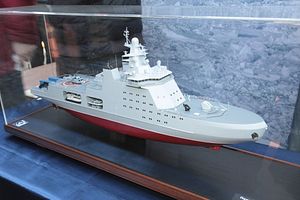Russia’s latest class of icebreakers, the so-called Project 23550 Ice-class patrol ship, may be armed with cruise missiles, the commandant of the U.S. Coast Guard, Admiral Paul F. Zukunft, told lawmakers in a public hearing on Coast Guard requirements, priorities, and future acquisition plans on May 18.
“We see Russia with their 40 [icebreakers], right now, they’re still building their fleet out, prepared to deliver two icebreaking corvettes that will carry cruise missiles in the year 2020,” Zukunft told the House Appropriations Homeland Security Subcommittee last week.
Russia’s JSC Admiralty Shipyards, a subsidiary of the United Shipbuilding Corporation (USC), laid down the lead ship of the new Project 23550 class, the Ivan Papanin, on April 19, according to media reports. The second ship of the class is supposed to be laid down later in the year or in early 2018. Build time for the new armed icebreakers is 36 months. The lead ship of the class is expected to be commissioned in 2019 or 2020.
The 7,000-ton Ivan Papanin will purportedly be armed with a 76-millimeter AK-176MA naval gun in a turret designed to provide a low radar cross-section and with up to eight containerized 3M-54 Kalibr supersonic anti-ship cruise missiles. However, the Russian Ministry of Defense has not confirmed the exact armament of the new ships (some sources refer to a 100-millimeter A-190 naval gun and two containerized cruise missiles).
According to an unnamed Russian defense industry source interviewed by IHS Jane’s, the new icebreakers will be fitted with a modular armament suite. The source also emphasized that the new ship will not be “an icebreaker armed with an AK-176MA naval gun, but a fully featured combatant designed in accordance with the navy’s requirements for ships of such a class; she can break ice with a thickness of up to 1.7 m.”
The ship will also be fitted with a hangar capable of accommodating a Ka-27 anti-submarine warfare helicopter.
Russia currently operates 40 icebreakers and will commission over a dozen additional ships in the coming years. It is expected to commission the lead ship of its new class of nuclear-powered icebreakers in 2019, as I explained elsewhere:
The ship was launched in June 2016. The remaining two vessels of the class were reportedly already laid down and are expected to be commissioned in 2019 and 2020 respectively. June 2016, also saw the launch of the 6,000-ton Project 21180 diesel-electric icebreaker Ilya Muromets, Russia’s first new military icebreaker in half a century.
“We need to look differently … at what an icebreaker does,” Zukunft said during the hearing on May 18. “We need to reserve space, weight, and power if we need to strap a cruise missile package on it.” Yet the Coast Guard still has a long way to go to build up its capabilities, as I reported elsewhere (See: “Russia and China in the Arctic: Is the US Facing an Icebreaker Gap?”):
[T]he United States currently operates two polar icebreakers: the Polar Star and the Healy. However, only the Polar Star is a heavy icebreaker capable of accessing all of the Arctic year-round. (The Polar Star’s sister ship, the Polar Sea, had a major engine breakdown in 2010 and has not been operational ever since.) Furthermore, the Polar Star, commissioned in 1976, is slated to reach the end of its operational lifespan in 2020.
In February 2017, the U.S. Coast Guard awarded five firm fixed-price contracts for heavy polar icebreaker design studies and analysis for the United States’ new class of icebreaking vessels. The study is expected to be completed within 12 months. The first new heavy icebreaker is tentatively slated for delivery in 2023.
Meanwhile, China in December 2016, started construction of its first domestically-built icebreaking research vessel. In December of the previous year, the Chinese People’s Liberation Army Navy commissioned the lead ship of a new class of icebreakers, the Type 272 Hai Bing 722, into its Northern Fleet. In March 2016, the PLAN commissioned its sister ship, the Hai Bing 723.

































